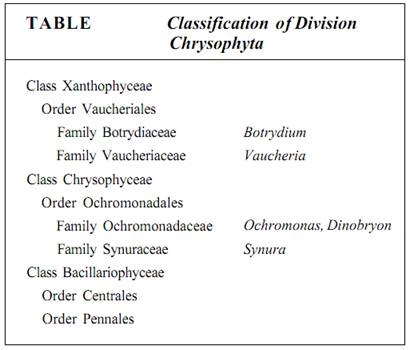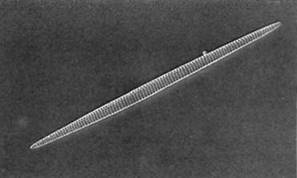

النبات

مواضيع عامة في علم النبات

الجذور - السيقان - الأوراق

النباتات الوعائية واللاوعائية

البذور (مغطاة البذور - عاريات البذور)

الطحالب

النباتات الطبية


الحيوان

مواضيع عامة في علم الحيوان

علم التشريح

التنوع الإحيائي

البايلوجيا الخلوية


الأحياء المجهرية

البكتيريا

الفطريات

الطفيليات

الفايروسات


علم الأمراض

الاورام

الامراض الوراثية

الامراض المناعية

الامراض المدارية

اضطرابات الدورة الدموية

مواضيع عامة في علم الامراض

الحشرات


التقانة الإحيائية

مواضيع عامة في التقانة الإحيائية


التقنية الحيوية المكروبية

التقنية الحيوية والميكروبات

الفعاليات الحيوية

وراثة الاحياء المجهرية

تصنيف الاحياء المجهرية

الاحياء المجهرية في الطبيعة

أيض الاجهاد

التقنية الحيوية والبيئة

التقنية الحيوية والطب

التقنية الحيوية والزراعة

التقنية الحيوية والصناعة

التقنية الحيوية والطاقة

البحار والطحالب الصغيرة

عزل البروتين

هندسة الجينات


التقنية الحياتية النانوية

مفاهيم التقنية الحيوية النانوية

التراكيب النانوية والمجاهر المستخدمة في رؤيتها

تصنيع وتخليق المواد النانوية

تطبيقات التقنية النانوية والحيوية النانوية

الرقائق والمتحسسات الحيوية

المصفوفات المجهرية وحاسوب الدنا

اللقاحات

البيئة والتلوث


علم الأجنة

اعضاء التكاثر وتشكل الاعراس

الاخصاب

التشطر

العصيبة وتشكل الجسيدات

تشكل اللواحق الجنينية

تكون المعيدة وظهور الطبقات الجنينية

مقدمة لعلم الاجنة


الأحياء الجزيئي

مواضيع عامة في الاحياء الجزيئي


علم وظائف الأعضاء


الغدد

مواضيع عامة في الغدد

الغدد الصم و هرموناتها

الجسم تحت السريري

الغدة النخامية

الغدة الكظرية

الغدة التناسلية

الغدة الدرقية والجار الدرقية

الغدة البنكرياسية

الغدة الصنوبرية

مواضيع عامة في علم وظائف الاعضاء

الخلية الحيوانية

الجهاز العصبي

أعضاء الحس

الجهاز العضلي

السوائل الجسمية

الجهاز الدوري والليمف

الجهاز التنفسي

الجهاز الهضمي

الجهاز البولي


المضادات الميكروبية

مواضيع عامة في المضادات الميكروبية

مضادات البكتيريا

مضادات الفطريات

مضادات الطفيليات

مضادات الفايروسات

علم الخلية

الوراثة

الأحياء العامة

المناعة

التحليلات المرضية

الكيمياء الحيوية

مواضيع متنوعة أخرى

الانزيمات
Division Chrysophyta
المؤلف:
AN INTRODUCTION TO PLANT BIOLOGY-1998
المصدر:
JAMES D. MAUSETH
الجزء والصفحة:
19-11-2016
2864
Division Chrysophyta
Mambas of division Chrysophyta are grouped into three classes: Bacillariophyceae (diatoms Table ), Chrysophyceae (golden brown algae), and Xanthophyceae (yellow-green algae). Many phycologists think each of tee groups should have its own division, whereas others think they should be classified as brown algae. Division Chrysophyta all have chlorophylls a and c, store their reserve carbohydrate as the polymer chrysolaminarin, and have such abundant accessory carotene and xanthophyll pigments that they mask the chlorophylls. Some have cellulose walls that are frequently encrusted with either silica or calcium carbonate; others have walls with no cellulose but only silica embedded in a matrix of pectin. Some have two anterior, unequal flagella.

CLASS BACILLARIOPHYCEAE: DIATOMS
Class Bacillariophyceae contains about 200 genera and 5000 species. Diatoms are easy to recognize because of their distinctive morphology. Each cell has a wall composed of two halves or frustules that fit together like a Petri dish and its lid. Each frustule is encrusted with silica, and when the diatom dies and the protoplasm degenerates, the siliceous frustules sink to the ocean floor and accumulate. Such deposits, known as diatomaceous earth, can become hundreds of meters thick and cover many square kilometers (Fig. 1). Accumulations of this volume are possible because diatoms are the most abundant organisms in the oceans, and a single liter of sea water may easily contain more than 1 million individuals.

FIGURE 1:The true immensity of the deposits of microscopic diatom fossil frustules is difficult to imagine. This is a mine of diatomaceous earth or diatomite. The frustules are excellent as polishing material or as filtering agents in water purification plants and swimming pools. (Courtesy of the Celete Corporation, Lompoc, California)
It might be thought that organisms consisting of a single cell could not possibly be very complex and certainly would not have enough structure to allow 5000 species to be recognized, but frustules are extremely intricate. Where the two come together, they are held in place by girdle bands, and each species has its own characteristic complicated pattern of ridges, depressions, and pores. The cells are either round in face view (centric diatoms) or elongate (pennate diatoms) (Fig. 2).
When a diatom undergoes mitosis and cytokinesis, each progeny cell receives one of the frustules from the parental cell, using it as its outer frustule and synthesizing a new inner frustule. All cells that receive the inner frustule automatically mature into a cell that is smaller than the parent cell, and average cell size decreases with each cell cycle. This obviously cannot go on forever, and when a cell reaches a critical small size, sexual reproduction is triggered. The cells undergo meiosis, some producing 4, 8, or 16 sperm cells, others producing just one or two large egg cells. After fertilization, the zygote grows into a large cell, then becomes dormant, surrounded by a wall different from that of a vegetative cell. The zygote finally "germinates," undergoing a round of nuclear and cell division, and reinitiating the process of decreasing cell size.

FIGURE 2:Like all pennate diatoms, this Nitzschia pungens is extremely elongate and bilaterally symmetrical. One of its varieties, N. pungens forma multiseries, produces a neurotoxin as the blooms senesce. The toxin is domoic acid, which causes the syndrome amnesiac shellfish poisoning (X 1000). (Courtesy of Greta Fryxell, Texas A and M University)
CLASS CHRYSOPHYCEAE: GOLDEN BROWN ALGAE
Class Chrysophyceae contains about 70 genera and 325 species of golden brown algae (Table ). These are biochemically similar to diatoms but differ in not having frustules. Instead, the single cells, such as those of Synura, are covered with numerous tiny siliceous scales that develop within special vesicles in the endoplasmic reticulum (Figs 3). Cells may be either uniflagellate or biflagellate; rarely they have no flagella, crawling by ameboid motion instead. Although they are photoautotrophic because of their chloroplasts, they can also ingest bacteria by phagocytosis.
Golden brown algae are particularly important because of their past biology. The living cell float in warm, sunny surface waters, like diatoms, but when they die, the lack of swimming motion allows their dense siliceous scales or frustules to sink and accumulate on the ocean floor. The remains of both diatoms and golden brown algae, especially a group known as coccolithophorids (usually called coccoliths), are relatively inert and do not decompose. Drilling into seafloor sediments makes it possible to analyze the amount of diatom and coccolith remains and to estimate the rate at which they accumulated. It is possible to reconstruct the surface climate: Accumulation was rapid when waters were warm and carbon dioxide was abundant for photosynthesis and slow when the climate was cod or if carbon dioxide was low. Shallow coastal seas tend to be warmer than the open oceans, and this also affects coccolith growth and reproduction. By also analyzing fossil animals, which are affected by temperature but not carbon dioxide, we can reconstruct past climates and ocean basin geology precisely.

FIGURE 3:Each cell of a golden brown alga is covered with many minute scales that are formed within vesicles of the endoplasmic reticulum. The pattern within each scale is constant for each species, but how it is controlled is unknown. Synura uvella (X 5000). (Courtesy of R. E. Andersen, Bigelow Laboratory for Ocean Science).
CLASS XANTHOPHYCEAE: YELLOW-GREEN ALGAE
Yellow-green algae ( Table ) occur mostly in fresh water, and formerly nay were thought to be green algae until chlorophyll c was discovered in them. They are somewhat diverse, some being unicellular, some filamentous, and some forming giant multinucleate cells. Filamentous forms, such as Tribonema, have walls like diatom frustules, each cell having two half-walls, but each of these frustule-like walls is firmly attached to the half-wall of the neighboring cell. Although the cells remain together, the organism can be called multicellular only in the broadest sense, because no differentiation or specialization occurs in any part: The filament is really just a colony of individuals that happen to remain together.
Some yellow-green algae, such as Vaucheria, have an unusual body that consists of a long tubular coenocyte with a single large central vacuole, a thin peripheral layer of cytoplasm, and thousands of nuclei. During asexual reproduction, the cytoplasm at the tip of a tube is isolated by a transverse wall, and pairs of flagella form near each nucleus; then the old wall breaks open, and the multiflagellate "cell" swims slowly away (Fig. 4a). It soon loses its flagella and begins growth at each end, forming a new tube. The greatest complexity is displayed during sexual reproduction. A mass of cytoplasm is walled off and pairs of flagella form, but then each nucleus organizes the protoplasm around it into an individual cell. When the original wall breaks down, numerous biflagellate sperm cells swim always (Fig. 4b). An egg cell is formed as a small multinucleate protrusion on a tube, but as the cross wall forms, all nuclei except one migrate out, leaving a single large uninucleate cell. After fertilization the zygote forms a thick wall and is abscised from the parent branch. After a period of dormancy, the zygote undergoes meiosis and germinates, forming a new tube filled with haploid nuclei.

FIGURE 4: (a) Vaucheria occasionally walls off the tip of a coenocyte; then pairs of flagella form near each nucleus. The wall breaks open and the "cell" swims away, settles, and grows into a new individual (X 100). (T. E. Adams/Visuals Unlimited) (b) During sexual reproduction, one segment of the coenocyte forms numerous biflagellate sperm cells, and another forms one large uninucleate egg. After the sperm cells swim away, all that is left of the gametangium is wall; unlike gametangia in true plants, no protective layer of sterile cells is present (X 200). (R Calentine/Visuals Unlimited).
 الاكثر قراءة في الطحالب
الاكثر قراءة في الطحالب
 اخر الاخبار
اخر الاخبار
اخبار العتبة العباسية المقدسة

الآخبار الصحية















 قسم الشؤون الفكرية يصدر كتاباً يوثق تاريخ السدانة في العتبة العباسية المقدسة
قسم الشؤون الفكرية يصدر كتاباً يوثق تاريخ السدانة في العتبة العباسية المقدسة "المهمة".. إصدار قصصي يوثّق القصص الفائزة في مسابقة فتوى الدفاع المقدسة للقصة القصيرة
"المهمة".. إصدار قصصي يوثّق القصص الفائزة في مسابقة فتوى الدفاع المقدسة للقصة القصيرة (نوافذ).. إصدار أدبي يوثق القصص الفائزة في مسابقة الإمام العسكري (عليه السلام)
(نوافذ).. إصدار أدبي يوثق القصص الفائزة في مسابقة الإمام العسكري (عليه السلام)


















